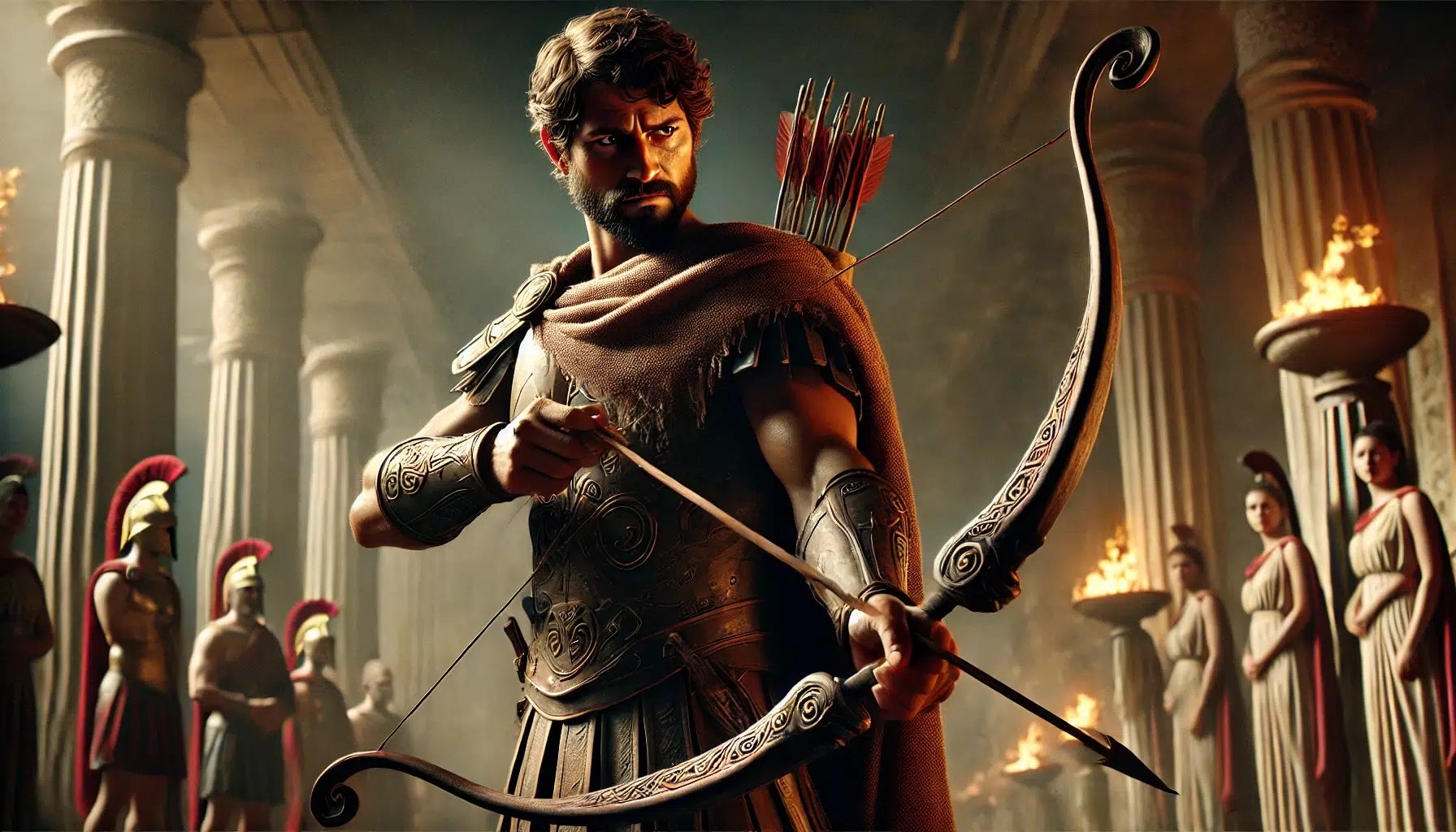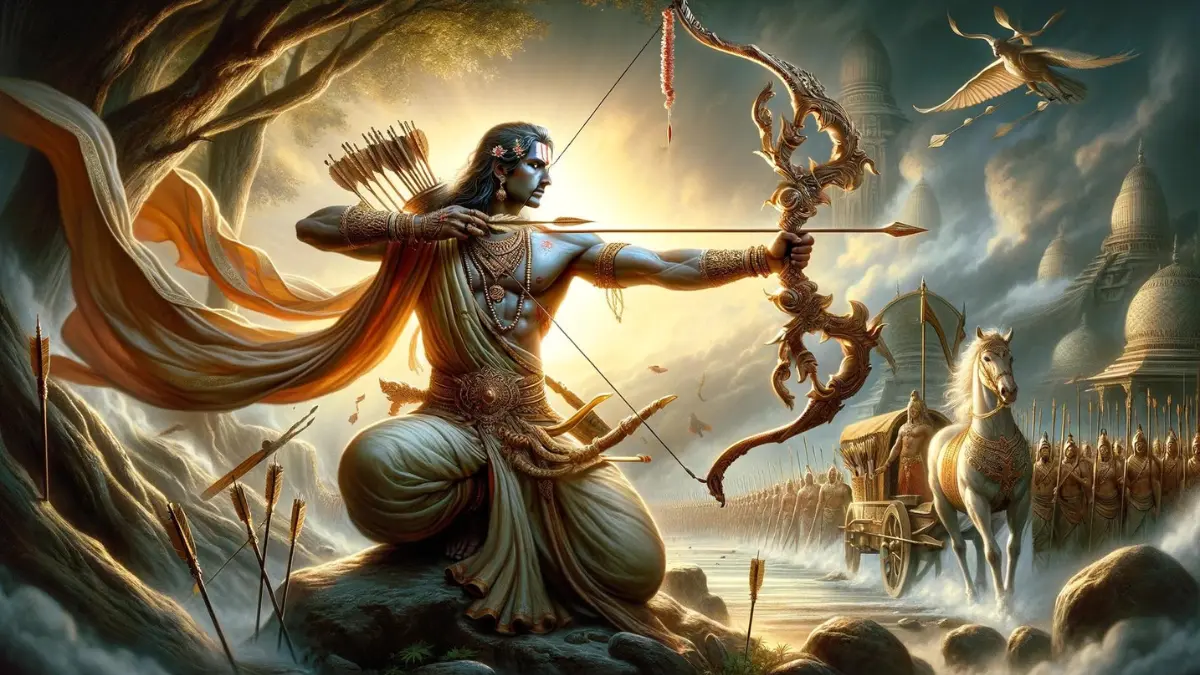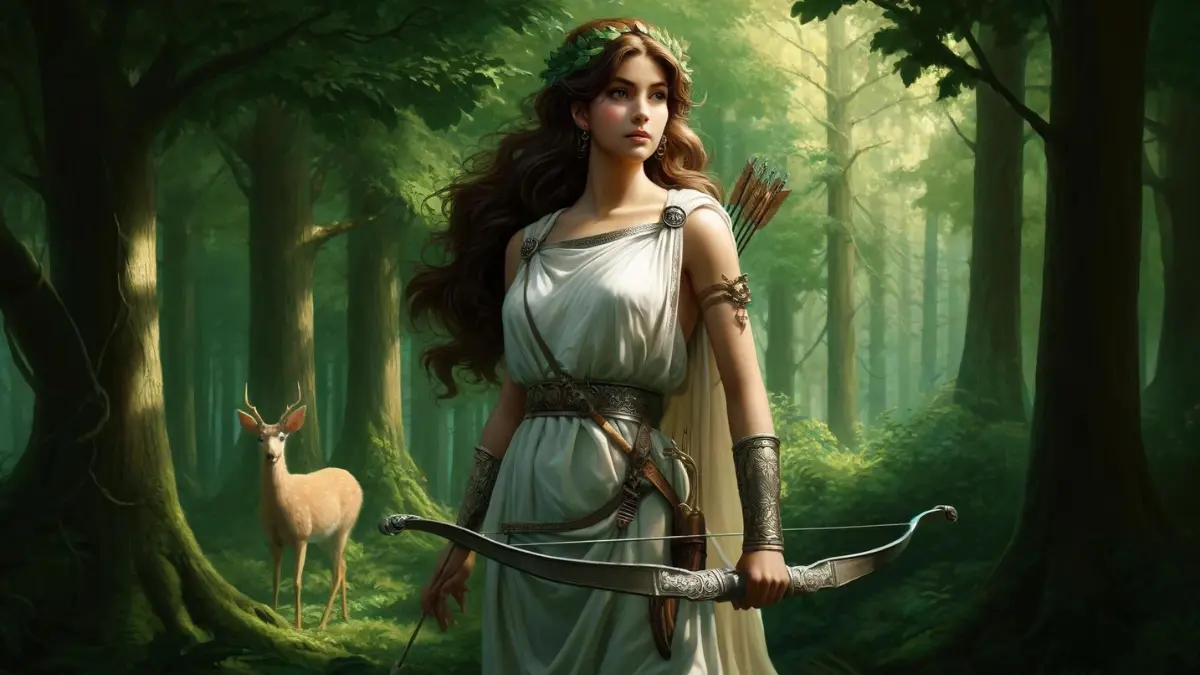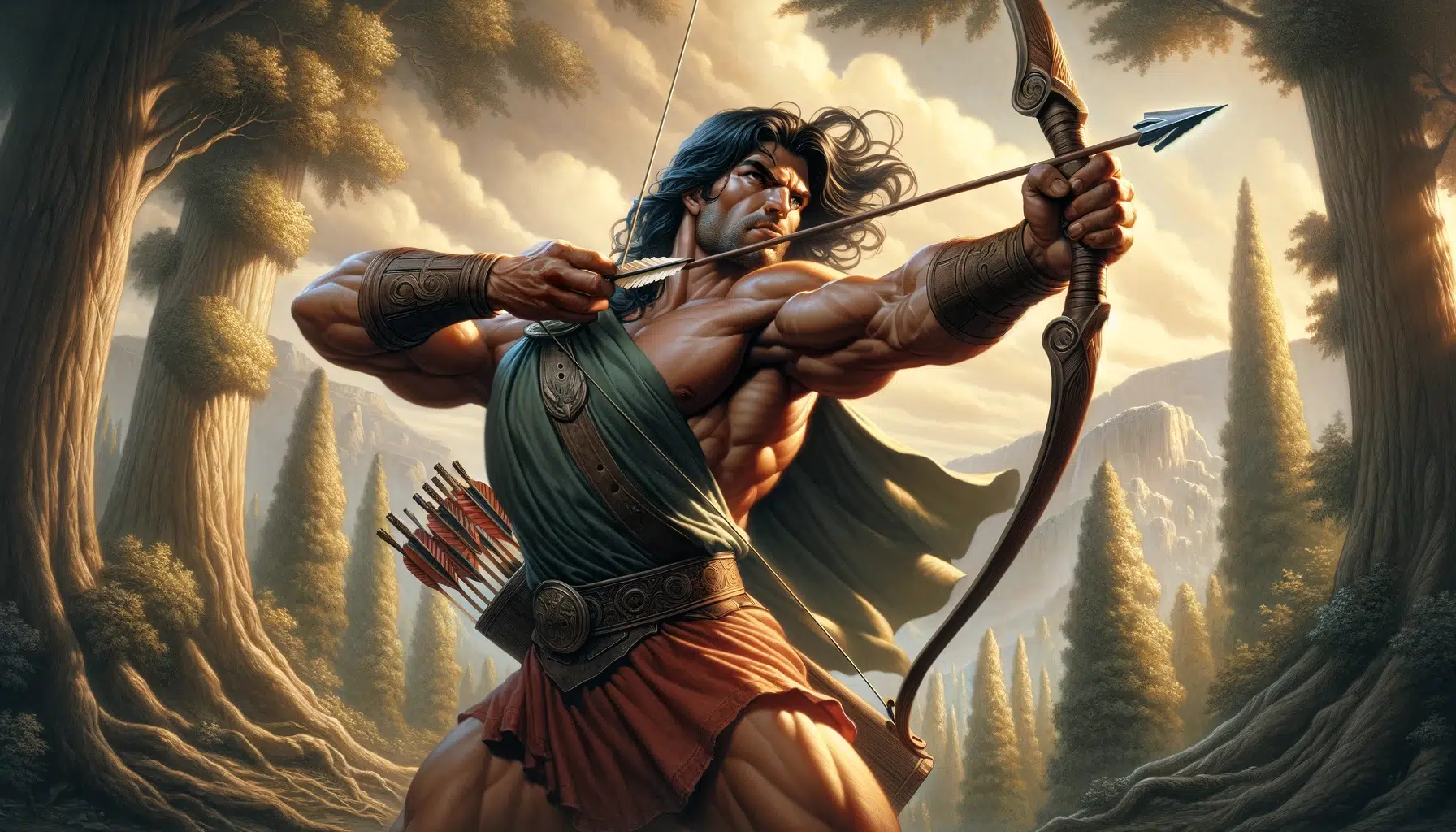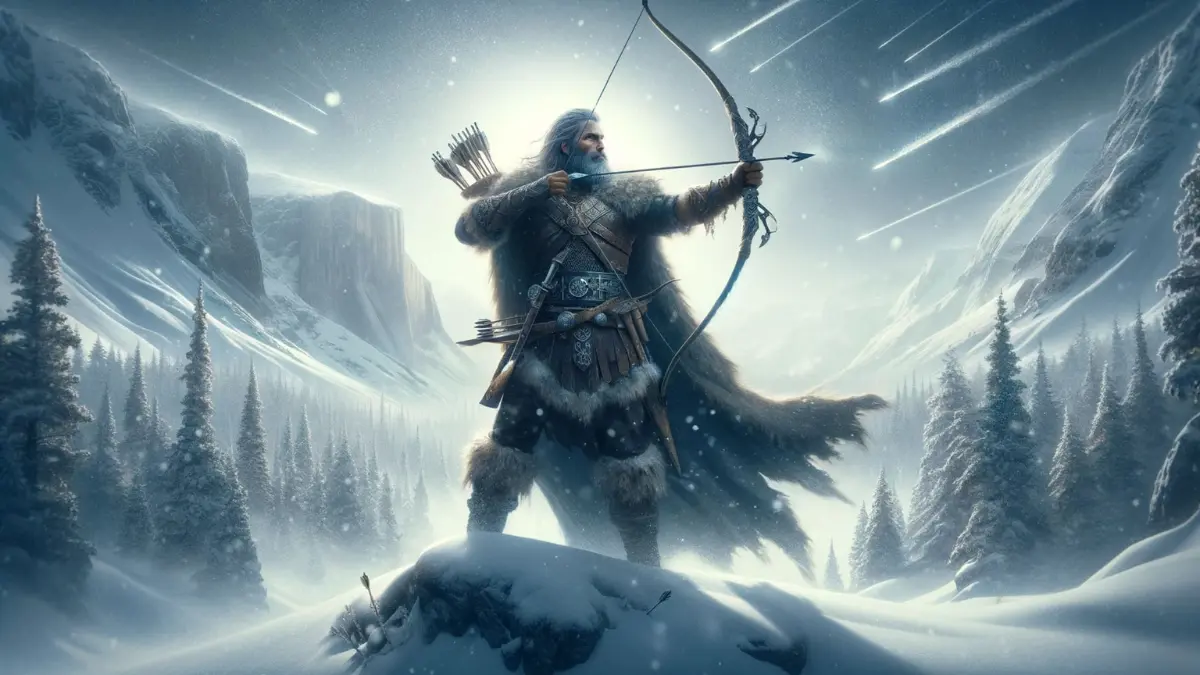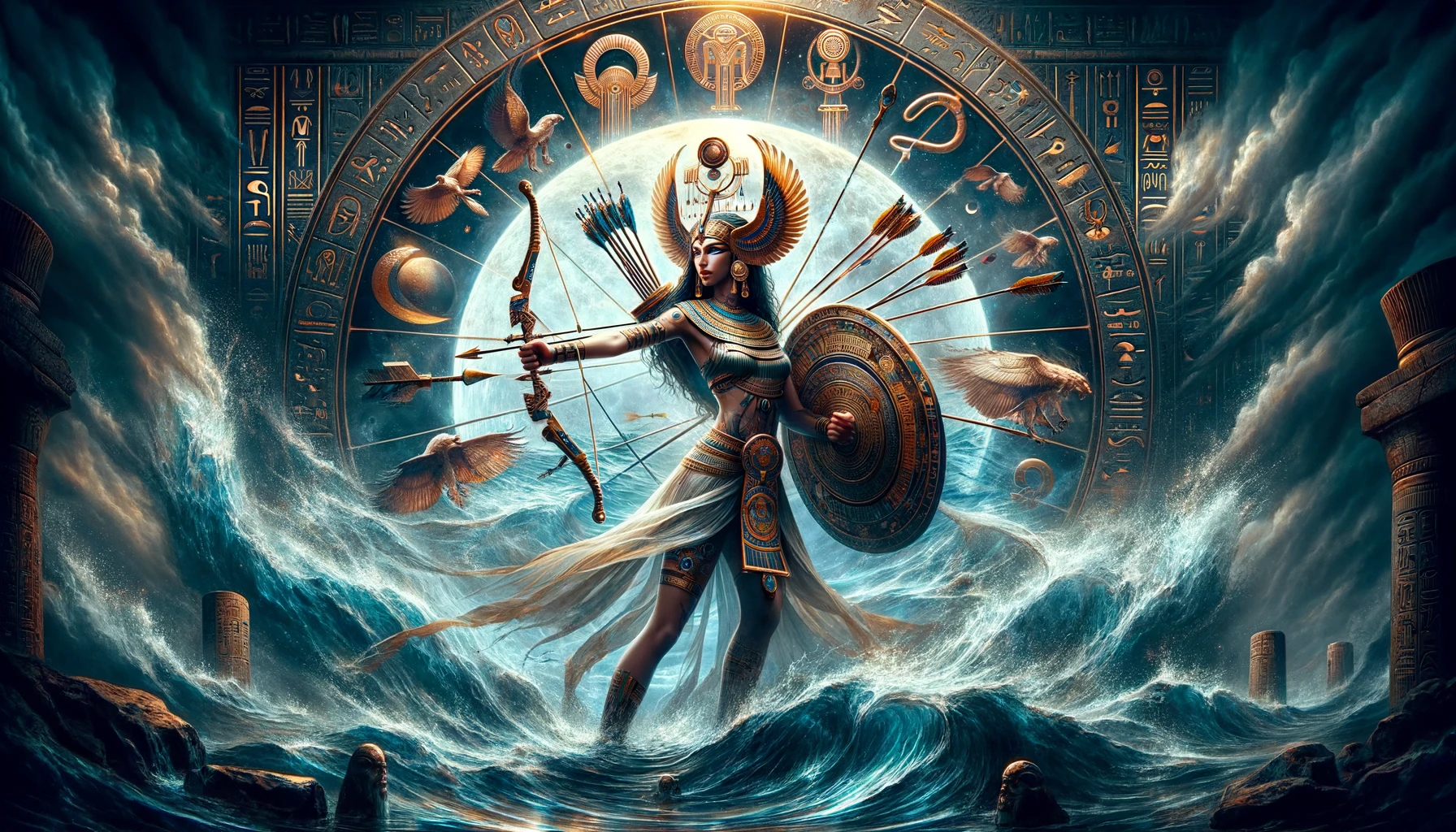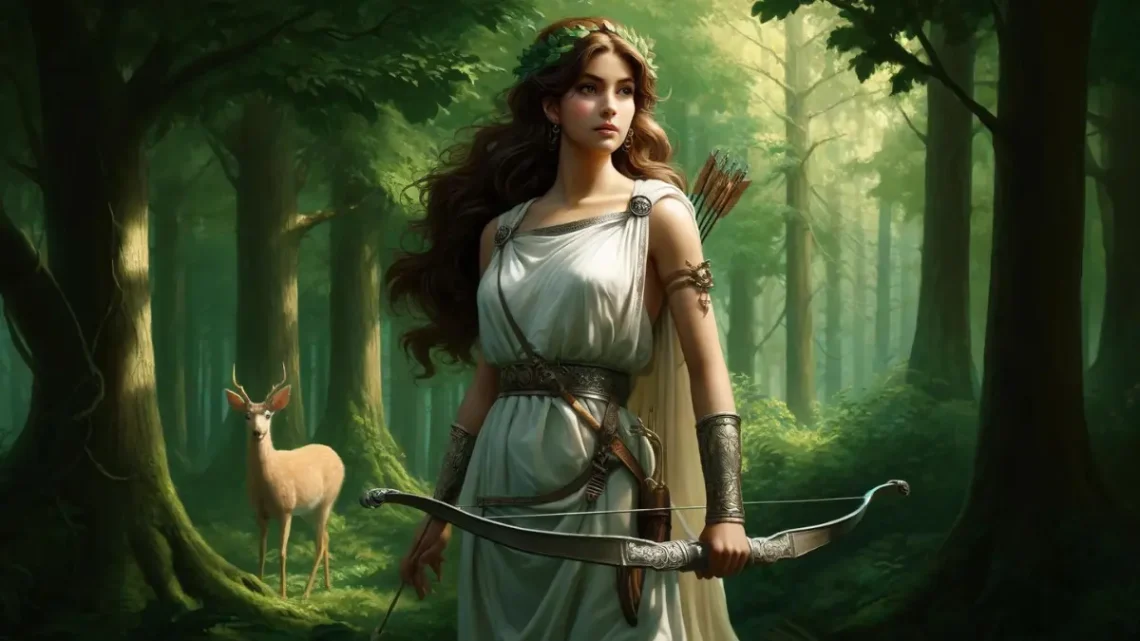
Archers From Mythology and Their Legendary Bow
Throughout mythology, famous archers have wielded their legendary bow that hold immense power and shape their destinies. These bows serve as powerful symbols, representing the archers’ skills, prowess, and their impact on the world of mythology.
From gods and goddesses to epic heroes, archery has been a symbol of skill, power, and spiritual connection. Throughout history, famous archers in mythology have wielded legendary bows, showcasing their prowess and shaping the destiny of their realms.
Odysseus and His Legendary Bow
| Odysseus | |
|---|---|
| Mythology | Greek Mythology |
| Famous for | His 10-year journey home after the Trojan War |
| Skills and Abilities | Exceptional strength and skill in archery |
| Myths or Stories | – Return to Ithaca and the Suitors – Encounter with Polyphemus the Cyclops – Circe the Enchantress – The Sirens, Scylla, and Charybdis |
| Symbolism of the Bow | Represents Odysseus’ rightful place as king and his unmatched prowess |
Odysseus’ bow is described as large and difficult to string, requiring great strength that only Odysseus possessed. This physical trait of the bow symbolizes his unique capabilities and his rightful place as the leader of Ithaca.
In the Odyssey, the bow is central to the story’s climax. Odysseus, the hero, proves his identity and eliminates the suitors vying for his wife’s hand. The bow also carries divine protection and favour, symbolizing Odysseus’ cunning and the support he receives from the gods.
This legendary bow has a lasting cultural and historical impact, frequently appearing in Greek art and literature as a symbol of heroism and rightful leadership. Odysseus’ legacy, intertwined with his bow, continues to be a powerful representation of strength, skill, and rightful authority.
Arjuna and His Gandiva
| Arjuna | |
|---|---|
| Mythology | Hindu Mythology |
| Famous for | – His crucial role in the Kurukshetra War – His dialogue with Krishna, known as the Bhagavad Gita |
| Skills and Abilities | – Greatest archer of his time, mastering various celestial weapons |
| Myths or Stories | – Kurukshetra War and the Bhagavad Gita – Acquisition of Divine Weapons – Duel with Karna – Role as a Disciple and Friend of Krishna |
| Symbolism of the Bow | – Represents divine favour and the extraordinary prowess of Arjuna – Symbol of justice and righteousness in the battle for dharma |
The Gandiva, a divine bow given to the Pandava prince Arjuna by the fire god Agni, is one of the most powerful and revered weapons in Hindu mythology.
In the epic Mahabharata, the bow is incredibly powerful, capable of firing thousands of arrows in quick succession. It was instrumental in many of Arjuna’s victories in the Kurukshetra War.
Made from celestial materials, it is unbreakable and capable of firing an endless stream of arrows. The bow’s divine origin symbolizes the favour and protection of the gods.
With the Gandiva, Arjuna was able to defeat formidable opponents, turning the tide of battles in favour of the Pandavas. The bow’s presence in the epic serves as a testament to Arjuna’s valor and the moral high ground of his cause.
The Gandiva’s cultural and historical impact is profound. It symbolizes the virtues of heroism, divine support, and the triumph of good over evil.
It remains a potent symbol in Hindu culture, representing the ultimate weapon of a warrior dedicated to the protection of dharma.
Learn more about: Kaikeyi: The Misunderstood Queen of Hindu Epic
Artemis and Her Silver Bow
| Artemis | |
|---|---|
| Mythology | Greek Mythology |
| Famous for | – Protector of wildlife and young women – Renowned for her hunting skills and precision |
| Skills and Abilities | – Exceptional accuracy and speed in archery – Ability to bring swift retribution and protection |
| Myths or Stories | – Myth of Artemis and Actaeon – Artemis and Orion – Myth of Artemis and Agamemnon – Artemis and Niobe |
| Symbolism of the Bow | – Represents purity, independence, and connection to nature – Symbolizes the divine power and protection of Artemis |
Artemis, the Greek goddess of the hunt, wilderness, and the moon, wields a legendary silver bow gifted to her by her father, Zeus. This bow, elegant and formidable, symbolizes her purity, independence, and deep connection to nature. Artemis is renowned for her exceptional accuracy and speed in archery, making her a formidable protector of wildlife and young women. Her bow is a crucial tool in her role as a huntress and guardian.
In various myths, Artemis uses her bow to bring swift retribution and protection. During the Trojan War, she aids the Trojans, showcasing her divine intervention in human affairs. Another famous story involves her slaying the Niobids, the children of Niobe, to avenge an insult to her mother, Leto. These tales highlight her dual nature as both a nurturing and vengeful deity.
The Silver Bow of Artemis stands as a powerful emblem of her divine authority and skills. It represents the balance between nurturing and protecting the natural world and enforcing divine justice. Artemis’ legacy, intertwined with her bow, continues to inspire reverence for her role as a protector and huntress in Greek mythology. Her stories emphasize the enduring themes of purity, strength, and the unyielding power of nature.
Heracles and His Legendary Bow
| Heracles (Hercules) | |
|---|---|
| Mythology | Greek Mythology |
| Famous for | – Feats in the Twelve Labors – Numerous battles and heroic feats |
| Skills and Abilities | – Exceptional strength and accuracy with the bow – Mastery in using poisoned arrows dipped in Hydra’s blood |
| Myths or Stories | – The Twelve Labors of Hercules – Hercules and the Centaur Nessus – Myth of Hercules and Prometheus – Hercules and the Argonauts |
| Symbolism of the Bow | – Represents divine favour and immense strength – Symbolizes heroism and the triumph of good over evil |
Heracles’ bow, a gift from Apollo, features prominently in Greek mythology. The bow is powerful and symbolic, representing Heracles’ divine favor and unmatched strength. He uses it effectively in his Twelve Labors, notably to kill the Stymphalian birds. The bow, combined with arrows dipped in Hydra’s blood, adds a lethal edge to his arsenal, showcasing his strategic prowess.
The story of Heracles’ bow extends beyond his life. He bequeaths it to Philoctetes, whose use of the bow proves crucial in the Trojan War. This transfer signifies the continuity of heroism and divine favour. The bow’s physical attributes – strong, durable, and deadly – reflect the heroic qualities of its wielders.
Heracles’ bow symbolizes more than just a weapon; it embodies the virtues of strength, bravery, and divine support. It holds a significant place in Greek mythology and cultural history, representing the enduring legacy of one of Greece’s greatest heroes. Heracles’ feats, aided by this legendary bow, inspire countless stories of valour and triumph.
Hou Yi and His Divine Bow
| Hou Yi | |
|---|---|
| Mythology | Chinese Mythology |
| Famous for | – Shot down nine of the ten suns to save the Earth – Accomplished various heroic feats using his archery skills |
| Skills and Abilities | – Unparalleled precision and power in archery – Ability to achieve seemingly impossible feats with his bow |
| Myths or Stories | – Hou Yi and the Ten Suns – Myth of Hou Yi and Chang’e – Hou Yi and the Monsters – Myth of Hou Yi and the Moon Eclipse |
| Symbolism of the Bow | – Represents salvation, strength, and the protection of humanity – Symbolizes the intervention of a hero in times of crisis |
Hou Yi was a legendary archer in Chinese mythology. With this bow, Hou Yi performs one of the most celebrated feats: shooting down nine of the ten suns that scorched the Earth. This act saves humanity from destruction, showcasing Hou Yi’s exceptional precision and power in archery. His bow symbolizes salvation and protection, reflecting his role as a saviour.
Beyond this famous story, Hou Yi’s bow is central to various legends where he uses his archery skills to overcome challenges and protect people. The bow’s strength and accuracy highlight his heroic attributes and his critical interventions in times of crisis.
Hou Yi’s bow stands as a powerful emblem of his legendary status. It represents the virtues of heroism, strength, and divine intervention. In Chinese culture, Hou Yi and his bow are celebrated as symbols of resilience and the ability to overcome great odds. The stories of Hou Yi’s feats with his bow continue to inspire and resonate through generations, emphasizing the enduring legacy of his heroism.
Atalanta and Her Hunting Bow
| Atalanta | |
|---|---|
| Mythology | Greek Mythology |
| Famous for | – First to wound the Calydonian Boar – Won the footrace challenge set by her suitors |
| Skills and Abilities | – Exceptional speed and agility – Mastery in archery and hunting |
| Myths or Stories | – The Calydonian Boar Hunt – The Footrace and Marriage to Hippomenes – Voyage of the Argonauts – Wrestling March with Peleus |
| Symbolism of the Bow | – Represents independence and female prowess – Symbolizes the virtues of speed, agility, and precision |
Atalanta, a renowned huntress in Greek mythology, wields a legendary hunting bow that underscores her exceptional skills and independence. Known for her swiftness and mastery in archery, Atalanta uses her bow in many legendary feats. One of her most notable achievements is being the first to wound the Calydonian Boar during the famous hunt, a testament to her prowess and bravery.
Atalanta’s hunting bow symbolizes her independence and the virtues of speed, agility, and precision. In the myth of the Calydonian Boar Hunt, her skill with the bow sets her apart from her male counterparts, emphasizing her exceptional abilities. Another significant story involves her footrace with suitors, where she uses her speed and agility to remain unbeatable until tricked by Hippomenes with golden apples from Aphrodite.
Her bow, often depicted as finely crafted and deadly accurate, reflects her role as a trailblazing female figure in a male-dominated world. Atalanta’s hunting bow represents the breaking of traditional gender roles and the celebration of female strength and skill. Her legacy continues to inspire stories of empowerment, showcasing the enduring impact of her legendary archery and unyielding spirit.
Cupid’s Legendary Bow
| Cupid | |
|---|---|
| Mythology | Roman Mythology |
| Famous for | – Causes love and desire with his arrows – Influences numerous myths and stories through his archery |
| Skills and Abilities | – Expertly aims arrows to incite love or aversion – Wields two types of arrows: gold (love) and lead (aversion) |
| Myths or Stories | – Cupid and Psyche – Myth of Cupid’s Arrows – Cupid and Venus |
| Symbolism of the Bow | – Represents love, desire, and the power of attraction – Symbolizes the unpredictable nature of love and affection |
Cupid’s bow is iconic in Roman mythology, wielded by the god of love. With this bow, Cupid (Eros in Greek mythology) shoots arrows that cause individuals to fall deeply in love or, conversely, to feel aversion. His skill with the bow allows him to influence both gods and mortals, shaping countless myths and stories.
One of the most famous tales involving Cupid’s bow is the story of Cupid and Psyche. Here, his arrows play a crucial role in the unfolding romance and trials between the divine Cupid and the mortal Psyche. Cupid’s bow, with its gold and lead arrows, symbolizes the dual nature of love: capable of causing both joy and heartache.
The bow’s symbolism extends to the broader theme of love’s unpredictability and power. It represents the idea that love can strike anyone, anywhere, with sudden and profound impact. In art and literature, Cupid’s bow remains a potent symbol of love’s enchanting and sometimes capricious nature. Through his bow, Cupid continues to be a central figure in stories of romance and desire, embodying the timeless power of love.
Ullr and His Legendary Bow
| Ullr | |
|---|---|
| Mythology | Norse Mythology |
| Famous for | – Renowned for his unparalleled skill in archery – Recognized as a master of the bow among the Norse gods |
| Skills and Abilities | – Exceptional precision and power with the bow – Expertise in hunting and survival skills |
| Myths or Stories | – Ullr and the Ten Suns – Myth of Ullr and the Moon Eclipse – Ullr’s Guardianship of Asgard |
| Symbolism of the Bow | – Represents precision, hunting prowess, and survival – Symbolizes the connection between archery and natural elements |
Ullr, the Norse god associated with archery, hunting, and winter, was renowned for his exceptional skill with the bow. While specific stories about Ullr’s bow are less detailed, his association with archery makes his weapon legendary among the gods.
Ullr’s bow stands as a symbol of exceptional skill and precision in Norse mythology. Ullr, the god of archery and skiing, is celebrated for his mastery of the bow. His ability to hunt with unparalleled accuracy and power earns him a revered place among the Norse gods. Ullr’s expertise extends to his survival skills, showcasing his prowess in traversing snow and ice.
While specific stories about Ullr’s bow are sparse, his role as the god of archery underscores his significance. The bow symbolizes precision, hunting prowess, and a deep connection to the natural elements, particularly snow and ice. Ullr’s association with skiing further emphasizes his versatility and adaptability in harsh environments.
Ullr’s bow embodies the virtues of a skilled hunter and survivalist. It represents the harmony between man and nature, highlighting the importance of precision and expertise in the natural world. In Norse culture, Ullr remains a symbol of archery’s art and the enduring spirit of survival and adaptation. His legacy, reflected through his bow, continues to inspire tales of skill and resilience.
Apollo and His Legendary Bow
| Apollo | |
|---|---|
| Mythology | Greek Mythology |
| Famous for | – Used to bring sudden death or disease – Instrumental in the Trojan War, aiding the Trojans |
| Skills and Abilities | – Unmatched precision and power in archery – Ability to heal and bring plague with his arrows |
| Myths or Stories | – Apollo and Daphne – The Slaying of Python – Apollo and Cassandra – The Myth of Apollo and the Delphic Oracle – Apollo and Coronis |
| Symbolism of the Bow | – Represents duality of healing and destruction – Symbolizes divine power and retribution |
As the god of the sun, music, and prophecy, Apollo wields his golden bow with unmatched precision and power. His bow is a powerful symbol in Greek mythology, embodying both healing and destruction. He uses his bow to protect those he favours and punish those who offend him, showcasing his divine authority.
His arrows can bring sudden death or disease, as seen during the Trojan War when he sends a plague to the Greek camp in “The Iliad.”
The bow’s golden appearance emphasizes its divine origin and the god’s radiant, solar associations.
In Greek culture, Apollo’s bow represents the balance between life and death, healing and harm. It stands as a testament to the god’s multifaceted nature and his influence over both mortal and divine realms. Apollo’s legacy, intertwined with his bow, continues to be a central theme in art and literature, reflecting the enduring power and complexity of his character.
Skadi and Her Frost Bow
| Skadi | |
|---|---|
| Mythology | Norse Mythology |
| Famous for | – Renowned huntress and skier among the Norse gods – Avenged her father’s death by marrying Njord and securing compensation |
| Skills and Abilities | – Exceptional precision and power in archery – Mastery in hunting and skiing in icy terrains |
| Myths or Stories | – Skadi’s Quest for Vengeance and Marriage to Njord – Myth of Skadi and Loki’s Punishment – Skadi and Ullr – Sakdi Role in the Death of Balder |
| Symbolism of the Bow | – Represents the harsh and formidable nature of winter – Symbolizes resilience, independence, and the spirit of the hunt |
Skadi, the Norse goddess associated with bowhunting, skiing, winter, and mountains, wields a legendary frost bow that embodies her formidable skills and the harsh beauty of winter. Known for her exceptional precision and power in archery, Skadi uses her bow to hunt in the icy terrains of her mountainous realm. Her bow, often depicted as made of ice or imbued with frost, symbolizes her mastery over winter and her resilience in harsh conditions.
One of Skadi’s notable achievements involves avenging her father, the giant Thjazi. She secures compensation by marrying the sea god Njord, although their marriage ultimately fails due to their differing preferences for the mountains and the sea. Skadi also plays a significant role in Norse mythology by participating in the binding of Loki, further highlighting her strength and determination.
Skadi’s frost bow represents the formidable and unyielding nature of winter. It symbolizes resilience, independence, and the spirit of the hunt, reflecting Skadi’s role as a powerful and autonomous deity. Her legacy in Norse mythology emphasizes the themes of strength and perseverance in the face of adversity. The image of Skadi with her frost bow continues to inspire tales of the fierce and unrelenting spirit of winter.
Hachiman and His Yumi
| Hachiman | |
|---|---|
| Mythology | Japanese Mythology |
| Famous for | – Venerated as the god of war and archer – Protector of the samurai and their code of honour |
| Skills and Abilities | – Mastery in archery and martial prowess – Ability to provide divine protection and favour in battles |
| Myths or Stories | – Deification of Emperor Ōjin – Protector of Japan and the Kamikaze – Hachiman and the Minamoto Clan – Syncretism with Buddhism |
| Symbolism of the Bow | – Represents strength, protection, and martial virtue – Symbolizes the divine favour and guidance of warriors |
Hachiman Yumi, the bow associated with Hachiman, the Shinto god of war and archery, holds significant cultural and spiritual importance in Japanese mythology.
He is considered the divine protector of Japan and its people, particularly revered by samurai warriors. The bow, named after Hachiman, symbolizes strength, protection, and martial prowess.
Hachiman is venerated as the protector of the samurai, embodying the virtues of strength, honour, and martial prowess. His mastery in archery and his role as a divine guardian highlight the importance of the bow in both warfare and spiritual practices.
The Minamoto clan and other samurai revered Hachiman, seeking his favour and protection in their battles. The Hachiman Yumi symbolizes divine strength and the warrior’s code of honour, making it central to rituals and ceremonies aimed at securing success in warfare. This bow represents the divine guidance and support that Hachiman provides to those who uphold the values of bravery and righteousness.
Hachiman’s bow stands as a powerful emblem of martial virtue and divine protection. It reflects the deep connection between the spiritual and martial aspects of the samurai culture. The legacy of Hachiman Yumi continues to inspire reverence and respect, symbolizing the enduring bond between warriors and their divine protector in Japanese history and mythology.
Neith and Her Legendary Bow
| Neith | |
|---|---|
| Mythology | Egyptian Mythology |
| Famous for | – Protector of warriors and the dead – Revered as a creator goddess and a goddess of war and hunting |
| Skills and Abilities | – Mastery in archery and warfare – Ability to weave the destiny of gods and humans |
| Myths or Stories | – Neith as the Creation Goddess – Myth of Neith and the Contendings of Horus and Set – Neith as the Mother of Gods – Mistress of the Bow and Ruler of Arrows |
| Symbolism of the Bow | – Represents creation, protection, and destruction – Symbolizes the dual nature of life and death |
Neith, an ancient Egyptian goddess, wields a legendary bow that symbolizes her dual role as a creator and a warrior. As a master archer, Neith uses her bow to protect the living and the dead, embodying the themes of creation, protection, and destruction. Her bow represents the weaving of destiny, as Neith is also known for her skills in weaving and fate.
One of Neith’s notable achievements is her association with the creation of the universe and the gods. She is revered as a powerful deity who brings life and order. In addition, Neith plays a crucial role in the protection of the sun god Ra from the serpent Apep, using her bow to maintain balance and order in the cosmos.
The Bow of Neith stands as a powerful symbol of her divine authority and multifaceted nature. It represents the dual aspects of life and death, reflecting Neith’s ability to create and destroy. Her bow underscores her role as a protector and a formidable force in Egyptian mythology. Neith’s legacy, intertwined with her bow, continues to inspire reverence and respect, highlighting the enduring themes of creation, protection, and the balance of life and death.
Conclusion
The tales of famous archers and their bows in mythology vividly illustrate the enduring power and influence of archery in ancient lore. From the god of love Cupid to the epic heroes such as Odysseus and Arjuna, these archers have left an indelible mark on the mythological landscape.
Their exceptional archery skills, notable achievements, and valiant battles have immortalized them in mythology, captivating and inspiring us.
Through their mythological narratives, we witness the profound connection between archery and the mythical experience.
These stories highlight the prowess and bravery of these legendary archers, emphasizing their ability to shape destinies and overcome immense challenges through their skill with a bow and arrow.
The impact of their exploits resonates throughout history, reminding us of the enduring legacy of archery in mythology.


